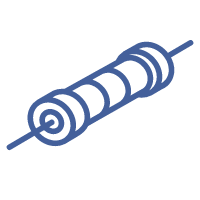
BI Technologies BPC10-472J
BPC10-472J
4-SMD, No Lead
39410796-BPC10-472J
Thick Film Resistors - Through Hole
- Mounting TypeSurface Mount
- Package / Case4-SMD, No Lead
- Surface Mount
having leads that are designed to be soldered on the side of a circuit board that the body of the component is mounted on.
NO - Terminal ShapeFLAT
- Mounting Feature
a process by which the operating system makes files and directories on a storage device (such as hard drive, CD-ROM, or network share) available for users to access via the computer's file system.
THROUGH HOLE MOUNT - Number of Terminals2
- PackageTape & Reel (TR)
- Base Product NumberSG-8101
- MfrEPSON
- Product StatusActive
- Package Description,
- Operating Temperature-Min-55 °C
- Operating Temperature-Max155 °C
- Rohs CodeYes
- Manufacturer Part NumberBPC10472J
- Package ShapeRECTANGULAR PACKAGE
- ManufacturerTT electronics / BI Technologies
- Part Life Cycle CodeActive
- Ihs ManufacturerBI TECHNOLOGIES CORP
- Risk Rank5.7
- Manufacturer SeriesBPC
- Operating Temperature
The operating temperature is the range of ambient temperature within which a power supply, or any other electrical equipment, operate in. This ranges from a minimum operating temperature, to a peak or maximum operating temperature, outside which, the power supply may fail.
-40°C ~ 85°C - SeriesSG-8101
- Size / Dimension0.197 L x 0.126 W (5.00mm x 3.20mm)
- Tolerance5%
- JESD-609 Codee3
- Pbfree CodeYes
- ECCN CodeEAR99
- Temperature Coefficient
The resistance-change factor per degree Celsius of temperature change is called the temperature coefficient of resistance. This factor is represented by the Greek lower-case letter “alpha” (α). A positive coefficient for a material means that its resistance increases with an increase in temperature.
100 ppm/°C - TypeXO (Standard)
- Resistance4700 Ω
- Terminal FinishMatte Tin (Sn)
- Additional Feature
Any Feature, including a modified Existing Feature, that is not an Existing Feature.
RATED AC VOLTAGE (V): 300 - HTS Code
HTS (Harmonized Tariff Schedule) codes are product classification codes between 8-1 digits. The first six digits are an HS code, and the countries of import assign the subsequent digits to provide additional classification. U.S. HTS codes are 1 digits and are administered by the U.S. International Trade Commission.
8533.21.00.90 - SubcategoryFixed Resistors
- TechnologyMETAL GLAZE/THICK FILM
- Voltage - Supply1.8V ~ 3.3V
- Resistor TypeFIXED RESISTOR
- Reach Compliance Codecompliant
- Frequency33.33 MHz
- Frequency Stability
the variation of output frequency of a crystal oscillator due to external conditions like temperature variation, voltage variation, output load variation, and frequency aging.
±15ppm - OutputCMOS
- FunctionEnable/Disable
- Base ResonatorCrystal
- Current - Supply (Max)6.8mA (Typ)
- Rated Power Dissipation (P)10 W
- Working Voltage500 V
- Current - Supply (Disable) (Max)3.5mA
- Rated Temperature70 °C
- Spread Spectrum Bandwidth
In telecommunication and radio communication, spread-spectrum techniques are methods by which a signal (e.g., an electrical, electromagnetic, or acoustic signal) generated with a particular bandwidth is deliberately spread in the frequency domain, resulting in a signal with a wider bandwidth.
- - Absolute Pull Range (APR)-
- Height Seated (Max)0.051 (1.30mm)
- Ratings-









